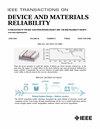脉冲激光沉积非晶p型n掺杂Ga₂O₃在薄膜晶体管和同结二极管中的应用
IF 2.3
3区 工程技术
Q2 ENGINEERING, ELECTRICAL & ELECTRONIC
IEEE Transactions on Device and Materials Reliability
Pub Date : 2025-04-09
DOI:10.1109/TDMR.2025.3559225
引用次数: 0
摘要
本研究采用脉冲激光沉积技术,制备了Ga2O3:GaN=1:1 (at%)的非晶p型掺n Ga2O3薄膜。利用x射线光电子能谱分析了氮掺入后膜的成键状态,发现晶格氧位被氮取代。紫外光电子能谱分析表明,n掺杂Ga2O3薄膜具有p型特征,纯Ga2O3薄膜具有弱n型特征。采用纯Ga2O3薄膜和掺n的Ga2O3薄膜分别制备了薄膜晶体管,进一步证实了其n型和p型导电性能。n掺杂ga2o3基tft具有p型特性,场效应迁移率为$2.13\ × 10{^{\text {-3}}}$ cm2/V $\cdot $ s,通断比为$2.78\ × 10{^{{4}}}$,亚阈值摆幅为0.15 V/dec。最后,制备了基于Ga2O3薄膜的全非晶pn同质结二极管,具有良好的整流特性,整流比为$1.46\ × 10{^{{2}}}$,理想系数为5.19。本文章由计算机程序翻译,如有差异,请以英文原文为准。
The Achievement of Pulse Laser Deposited Amorphous P-Type N-Doped Ga₂O₃ for Applying in Thin Film Transistor and Homojunction Diode
In this study, an amorphous p-type N-doped Ga2O3 thin film has been achieved using pulsed laser deposition and Ga2O3:GaN=1:1 (at%) mixed ceramic target. The bonding states of the films after nitrogen incorporation were investigated using X-ray photoelectron spectroscopy, which revealed the lattice oxygen sites substituted by nitrogen. Ultraviolet photoelectron spectroscopy analysis shows a p-type feature of N-doped Ga2O3 film and a weak n-type unintentional doped pure Ga2O3 film. The thin film transistors have been fabricated using pure and N-doped Ga2O3 films to further confirm their n-type and p-type conductive properties, respectively. The N-doped Ga2O3-based TFTs displays p-type characteristics with a field effect mobility of $2.13\times 10{^{\text {-3}}}$ cm2/V $\cdot $ s, an on/off ratio of $2.78\times 10{^{{4}}}$ and a sub-threshold swing of 0.15 V/dec. Finally, a full amorphous Ga2O3 films-based pn homojunction diode has been fulfilled and explored in detail, which displays a good rectifying characteristic with a rectification ratio of $1.46\times 10{^{{2}}}$ and an ideality factor of 5.19.
求助全文
通过发布文献求助,成功后即可免费获取论文全文。
去求助
来源期刊

IEEE Transactions on Device and Materials Reliability
工程技术-工程:电子与电气
CiteScore
4.80
自引率
5.00%
发文量
71
审稿时长
6-12 weeks
期刊介绍:
The scope of the publication includes, but is not limited to Reliability of: Devices, Materials, Processes, Interfaces, Integrated Microsystems (including MEMS & Sensors), Transistors, Technology (CMOS, BiCMOS, etc.), Integrated Circuits (IC, SSI, MSI, LSI, ULSI, ELSI, etc.), Thin Film Transistor Applications. The measurement and understanding of the reliability of such entities at each phase, from the concept stage through research and development and into manufacturing scale-up, provides the overall database on the reliability of the devices, materials, processes, package and other necessities for the successful introduction of a product to market. This reliability database is the foundation for a quality product, which meets customer expectation. A product so developed has high reliability. High quality will be achieved because product weaknesses will have been found (root cause analysis) and designed out of the final product. This process of ever increasing reliability and quality will result in a superior product. In the end, reliability and quality are not one thing; but in a sense everything, which can be or has to be done to guarantee that the product successfully performs in the field under customer conditions. Our goal is to capture these advances. An additional objective is to focus cross fertilized communication in the state of the art of reliability of electronic materials and devices and provide fundamental understanding of basic phenomena that affect reliability. In addition, the publication is a forum for interdisciplinary studies on reliability. An overall goal is to provide leading edge/state of the art information, which is critically relevant to the creation of reliable products.
 求助内容:
求助内容: 应助结果提醒方式:
应助结果提醒方式:


